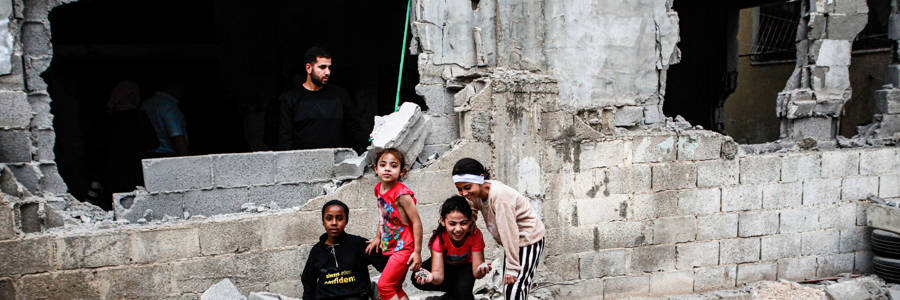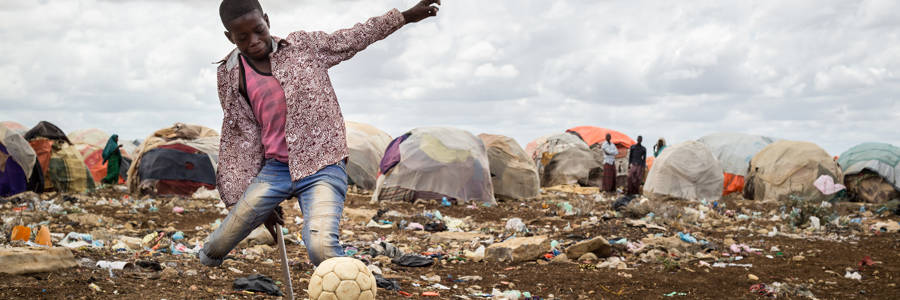Record high: One in five children in conflict zones
Posted Tuesday, 4 Nov 2025 by Gudrun Østby & Siri Aas Rustad

2024 was not a good year for peace. Conflict levels around the world stayed alarmingly high – in fact, the Uppsala Conflict Data Program (UCDP) logged more state-based conflicts than in any year since 1946. That makes 2024 the fourth most violent year since the end of the Cold War.
From Gaza to Sudan to Ukraine, the headlines keep reminding us of a painful truth: children are always among the hardest hit during conflict and war.
In addition to being directly exposed to grave violations such as killing and maiming, recruitment by armed groups, sexual violence, abduction, attacks on schools and hospitals, and denial of humanitarian access, children also suffer more indirectly from the consequences of war. Children living in conflict-affected areas are more likely to drop out of school, lack access to clean water and suffer from mortality risks due to illnesses and malnutrition, or lack of vaccines and medical care.
Today, Save the Children launches its new report Stop the War on Children – Security for Whom? The report is based on PRIO’s ninth annual mapping of children in armed conflict, now covering the period 1990–2024. Our latest estimates, covering the year 2024, suggest that as many as 520 million children – or more than 1 out of 5 of the world’s children – were living in a conflict zone. That is the highest number ever recorded.
How we measure children affected by conflict
Most conflicts occur within relatively small areas inside countries. To estimate how many children live in conflict zones, we first need to identify those specific areas.
Using data from the UCDP Georeferenced Events Dataset (UCDP GED), which records the exact locations of conflict incidents around the world (including geographic coordinates), we map each event and draw a 50 km radius around it. We then combine this with population data from CIESIN and the United Nations to estimate how many children live within those circles.
In simple terms, we define children affected by conflict as those living within 50 km of at least one lethal conflict event. This distance is chosen because it represents a reasonable range within which violence can disrupt children’s everyday lives – through insecurity, displacement or loss of access to essential services.
Key numbers
- In 2024, around 1.6 billion children – 65%, or roughly two out of three – were living in a conflict-affected country. 289 million children lived in countries experiencing high-intensity conflict.
- About 520 million children were living in conflict zones, defined as within 50 km of violent conflict events. That is, more than one in five children are affected by conflict worldwide – an all-time high both in absolute numbers and global share.
- Africa remained the region with the highest number of children in conflict zones, reaching 218 million in 2024.
- Africa also had the highest share of children living in conflict zones: 32.6%. For the first time since 2007, this share surpassed that of the Middle East.
What can be done to protect children in conflict?
With record numbers of children now living in conflict zones, the urgency to protect them couldn’t be clearer. Actors who work to address and reduce the impact of war on children should take the following measures:
- Build more systematic knowledge on the many ways in which children are affected by armed conflict.
- Ensure well-resourced and high-quality peacekeeping operations in conflict-affected areas.
- Work with local peacebuilders and put children’s needs at the centre of peace negotiations from the earliest stages.
- Establish safe spaces for children in conflict-affected areas.
- Design and uphold credible sanctions against armed groups to reduce all grave violations against children.
- Increase aid to conflict-affected countries to rebuild infrastructure – especially education and health systems for children – at this critical time when aid budgets are being cut.
For more information, read Save the Children’s full 2025 report, Stop the War on Children: Security for Whom?
For a policy brief describing our update of the annual mapping of children affected by armed conflict, read our PRIO Conflict Trends Policy Brief 01/2025: ‘Children Affected by Armed Conflict, 1990–2024’.











